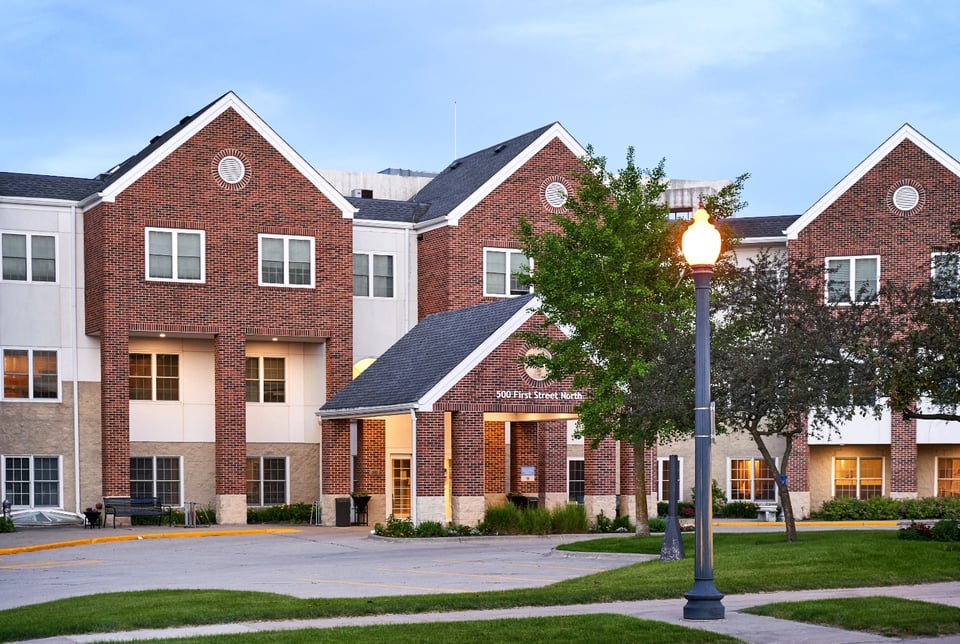If you or your loved one is struggling with activities of daily living (ADLs), the right form of support can go a long way toward making each day more convenient, safe, and enjoyable. Community living is an excellent option for accessing this sort of practical assistance, along with social opportunities and wellness-promoting programming and amenities.
Assisted living and memory care are both community living options, sometimes offered on the same campus, but each option comes with its own means of support.
Keep reading to learn how assisted living and memory care compare so you’re well-informed when making this important decision.
Memory Care vs. Assisted Living
What is the difference between assisted living and memory care? Both of these levels of living provide residents with the support needed to enjoy a comfortable, purposeful, and joyful life. And both are important to consider as you and your family weigh options, but they’re not interchangeable. The primary difference between memory care and assisted living is the level and type of support provided.
What is assisted living?
Assisted living balances independence and support by lending a helping hand only where it’s needed and allowing residents the freedom to enjoy life on their terms. Residents typically live in private apartments and enjoy common spaces for dining and socializing. Trained team members provide personalized, tailored care, including assistance with medication regimens, personal care, and mobility.
Learn more in The Complete Guide to Assisted Living.
What is memory care?
Memory care, also called memory support, shares some similarities with assisted living but is intended for residents living with forms of dementia, such as Alzheimer’s disease — a condition that affects about one in nine adults 65 and older. Dementia often presents unique challenges when a person lives independently. Memory care helps residents living with memory deficits enjoy fulfilling lifestyles supported by team members specifically qualified to understand their needs.
Learn more in The Complete Guide to Memory Care.
What are the differences between assisted living and memory care?
Let’s take a closer look at some of the key differences between assisted living and memory care so you can determine the appropriate option for you or your loved one.
|
Assisted Living |
Memory Care |
|
|
Safety |
Safe and accessible environment that prioritizes privacy and autonomy |
More supervision and safeguards to protect against common hazards |
|
Team Training and Expertise |
General expertise in assisting with ADLs and skilled nursing care |
Specialized expertise in caring for residents living with dementia |
|
Living Arrangements |
Private living spaces that may include kitchenettes, plus communal spaces |
Private living spaces with communal spaces for dining and socializing |
|
Wellness Therapies and Social Programming |
A variety of social programming opportunities from which to choose |
Therapies and programming designed specifically to support those with dementia |
|
Financial Costs |
Cost dependent on the level of support provided, but generally lower than memory care |
Generally higher cost due to the more extensive, specialized care involved |
|
Insurance Coverage |
Only necessary medical services are covered by health insurance; eligible for LTCI coverage |
Only necessary medical services are covered by health insurance; eligible for LTCI coverage |
Safety
Both assisted living and memory care promote a safe, supportive environment for residents, but safety measures differ in each level of living. Assisted living residents benefit from routine check-ins, quick access to nursing services when needed, and safe and accessible spaces designed to accommodate mobility challenges. Memory support includes a higher level of team member supervision and safeguards to prevent common issues like wandering. That doesn’t mean memory support households feel like hospitals, however. In memory care, residents benefit from 24/7 support in the comfort of a homelike environment rather than a clinical setting.
Team Training and Expertise
All our team members are trained to care for residents and help with daily activities. However, memory support team members are specially trained to work with residents living with dementia. Environments categorized as licensed CCDI (chronic confusion and dementing illness) households employ team members who work with residents to manage common challenges, such as disorientation and anxiety, while approaching their work with positivity and providing appropriate intellectual stimulation, opportunities for connection, and comfort.
Living Arrangements
Both assisted living and memory care emphasize independence and support and provide a range of amenities to make your new home as comfortable as possible. However, assisted living apartments, which come in a variety of floor plans, may include private living spaces and kitchenettes. In a memory care household, residents live in private rooms and enjoy communal living and dining spaces. Although not to the same degree as assisted living, memory care suites still afford privacy and, as with assisted living, allow residents and their families to personalize their space, making it feel like home.
Wellness Therapies and Social Programming
Both senior living options offer a robust calendar of social and educational events for residents. Individual and group programming — such as fitness classes, book clubs, and more — make each day engaging. The notable difference is that memory care programming may focus on the specific needs of residents with Alzheimer’s disease and other dementias. For example, music therapy can be especially enriching for memory care residents, as it can replace feelings of anxiety with familiarity and comfort. Some programming is available for residents across various levels of living, so those in assisted living and memory care can interact and enjoy enriching experiences together.
Financial Costs
Various factors determine the cost of senior living, one of which is the level of support offered. Memory care generally costs more than assisted living because it involves additional, specialized care. Assisted living costs an average of $70,800 annually, according to research from Genworth and CareScout, and memory care costs an average of $94,788, according to research from the National Investment Center for Seniors Housing & Care (NIC).
As you budget for senior living expenses, consider that both assisted living and memory support can eliminate or minimize some costs you or your loved one may be used to paying now, such as food and home maintenance expenses. Insurance and other sources of financial support also may make senior living arrangements more affordable.
Cost Coverage Strategies for Assisted Living and Memory Care
Entry fees and ongoing costs can vary between communities, but both assisted living and memory care can be expensive without a plan to cover care costs. Fortunately, a range of financial strategies and resources can help residents cover the cost of care.
Health Insurance
Medicare and private health insurance policies do not cover the full cost of assisted living or memory care. However, they may offer coverage for medically required services and therapies. For those who qualify, Medicaid can offer more comprehensive coverage for memory support. Your senior living team can help you navigate costs and insurance coverage.
Long-Term Care Insurance
Some people pay for a separate insurance policy to plan for future care costs, known as long-term care insurance (LTCI). These insurance policies can cover costs associated with assisted living or memory care if the policyholder files a valid claim establishing the need for care.
Continuing Care at Home Programs
Continuing care at home (CCaH) programs, like WellAhead — A WesleyLife Well-Being Experience, also provide a safety net for future care costs while allowing members to thrive at home for as long as possible. Members gain access to wellness-enhancing services from day one. If the need for more extensive care ever arises, they benefit from affordable access to the level of care that best fits their needs, whether that be assisted living, memory care, or another option.
Private Pay Strategies
Many residents use private pay options to cover their costs. Common funding sources include personal savings, investments, and retirement funds, along with monthly income from Social Security and pensions. If you own your home, selling or leasing it also can provide income to cover your costs.
Tax Deductions
Residents in both assisted living and memory care may qualify for a medical expense deduction from the IRS, which can help offset costs. Assisted living residents qualify for this deduction if they need assistance with at least two ADLs, whereas anyone who requires care for dementia automatically qualifies.
Choosing the Right Solution for You or Your Loved One
Choosing between memory care and assisted living depends on a few factors. Ask yourself the following questions:
- How independent is your loved one?
- How much help with the activities of daily living does your loved one need?
- Is your loved one demonstrating signs of memory loss?
- Has your loved one become disoriented or begun to wander?
- Has your loved one been diagnosed with a form of dementia?
If your loved one experiences dementia-related challenges, memory support will likely be the best fit for their needs. However, if the challenges they experience are related to physical or age-related limitations rather than cognitive complications, then assisted living may provide all the support they need and afford greater independence.
Remember, when you choose a community with a full continuum of care, you can always start in assisted living and move to memory care if your needs evolve. Communities that offer both assisted living and memory care allow for a seamless transition and continued familiarity and friendships.
Assisted living and memory care are just two valuable options among many other senior living solutions. Discover the best solution for your loved one by taking this short senior living assessment.





